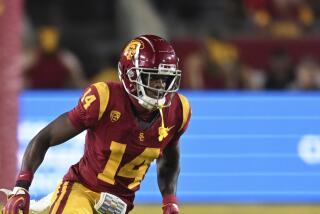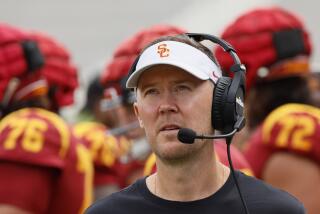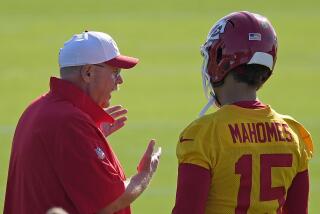THE NFL DRAFT : GETTING READY : Most College Prospects Will Do Anything NFL Scouts Request, but After a While They Say, Enough Already
For many college seniors, today is the big day, the first day of the National Football League draft. For those chosen today, the wait is over. For the rest, life in limbo will continue until Monday.
That life in limbo started when the final gun went off in their final college games, triggering what the NFL calls âthe draft preparation period.â
Every NFL team sends scouts around the country in search of the best talent. Every team tries to âout-scoutâ its rivals by testing potential draftees.
Despite available information on every senior from previous tests, scouts still show up on college campuses to work out players and gather more information to feed into computers. Some teams--the Denver Broncos, Dallas Cowboys and San Francisco 49ers--reportedly spend more than $1 million a year just on scouting.
There also are two scouting combines: United, which serves 19 teams, and BLESTO, which serves 7. The 49ers and the Raiders do not belong to either combine but all teams share in the cost of a special combine meeting for draft eligibles each year. This year, 332 players went to Indianapolis for testing the week after Super Bowl XXII.
Even after attending the combine workouts, though, players are still visited by scouts, some almost daily. From the beginning of February until draft day, scouts fly into town and, on a momentâs notice, put players through their own drills.
Some refer to the NFLâs draft preparation as âparalysis by over-analysis.â General Manager Jim Finks of the New Orleans Saints calls it overkill.
Finks told the New Orleans Times-Picayune: âWe are guilty of overkill. There is a big duplication of information. And weâre pestering the colleges to death by the way weâre on campuses, looking for more and more information all year round. We could spend a lot less money, be just as effective, maybe more so, and not bug the colleges as much as we do today.â
Tim McDonald, former USC All-American defensive back, got a good taste of draft preparation testing last year. McDonald, the first Southern California player chosen, was picked by the St. Louis--now Phoenix--Cardinals as the sixth pick in the second round, 34th overall.
âLast year, I went to the combine in late January,â McDonald said. âEvery team was there to watch us go through every test: the 40-yard dash, a 20-yard shuttle run, vertical jump, bench press and a complete physical. The combine seemed to be more important than your senior season itself, which is ridiculous.
âI did fine in every test, except that my 40-yard time was a little slow (4.7 seconds on artificial turf). But in the following months, I had to test again for scouts, on the average, three times a week. All the pressure was on at the combine, but the teams still came right back to test me. The worst that I ran was 4.65 on grass and I ran 4.58 for the Minnesota Vikings.
âSometimes, I would have to work out for more than one team in a day. I would test for one and then as I was leaving, test for another team.
âI was disappointed on draft day because I thought that I was a top 15 pick. My 40 time at the combine hurt me, even though that was the slowest 40 that I ran.
âI do not agree on how the combine and the draft process work. It is often too political. It can hurt some and then sometimes it does not matter, depending on the name of the player. The combine definitely weighs too heavily because some players who did not participate at the combine went from a fourth-round pick to a second, just by living off their name. All of the workouts after the combine seem irrelevant because the teams stick to what they want anyway.â
Derrick Taylor would probably agree with that. Taylor, a former North Carolina State cornerback, was not picked in last yearâs draft. He signed as a free agent with the New Orleans Saints, after months of testing for NFL teams.
âYou never knew when the scouts were coming in,â he said. âYou had to just keep yourself available for the scouts at any time.
âEven though I started for two years, I had to find out when the scouts were coming for our other cornerback, Nelson Jones (a fifth-round pick of the San Diego Chargers), in order to be prepared for a workout in advance.
âOnce I tested for the (Pittsburgh) Steelers on a bad ankle. The scout had me go through only a few drills at half speed because, he said, that he or someone else would be back to test me in a month. Yes, the Steelers did come back; they came back to test Nelson Jones, and not me.â
Taylor, who led the Saints in tackles during the three strike games, says that it is wrong how players are at the scoutsâ disposal.
âI worked out for any team interested, even if I was tired, hurt, or sick and still did not get drafted,â he said. âThe reason I worked out for so many teams was because the system is set up that way.â
Jerry Simmons, USC strength and conditioning coach, often is the liaison between the scouts and Trojan players.
âThe scouts are just doing their jobs, but when they all come in at different times, the players cannot get any kind of continuity with their workout schedule,â he said.
âI have seen three or four players a year injured because they are not able to work out properly. They are not able to get a good weight-room or conditioning cycle together. They want to be fresh, to go all out for the scouts, but they are not able to because they havenât conditioned themselves to do so.
âThe athletes then are prone to pulls and sprains, putting them out for two or three weeks for rehabilitation. What usually happens next is that NFL coaches and scouts are still calling, asking when (the player) can test for them and the player then comes back one week too soon and ends up getting hurt again.â
Multiple workouts in a day are major risks for the athletes. USC linebacker Keith Davis recalls one unexpected workout.
âOne day, I rode my bike to school at 9 a.m., to stretch and to get loose and warm for a scheduled 1 p.m. workout for the Rams, at Rams Park in Anaheim.
âAfter returning home at around 11 a.m. a Cardinal scout called and wanted me to work out for him, to see if I could improve on my time from the spring. I told him about my Ram workout but he said that he was not going to be around again until after the draft.
âI rode my bike back to school, warmed up again and worked out for him for about 40 minutes. I then hurried back home to drive to the Ram camp. By the time I got there, I was worn out. I did pretty well in both tests but I was really tired.
âI had to warm up good three times that day just to prevent from pulling a muscle. I figured that I had nothing to lose, working out for both teams in the same day but it was tough rushing around like that.â
Simmons suggests this solution to the problem: âThe players should set up specific workout days for scouts--three days in February, four days in March, and two in April. They can let the scouts know in advance that every senior will be available on these certain days.â
That can only work, though, if the players stick to the schedule, Simmons indicated.
âAt USC, we havenât had that much luck with this,â he said. âThe players are so concerned with working out for the scouts whenever the scouts want them to. But I think that the coaches and scouts would go along with this and make things easier on everyone.
âWe could get together with UCLA and make it a joint project in establishing set workout days for the players.â
John Arce, UCLAâs strength and conditioning coach, agrees.
âOverall, it would be easier on the players,â he said. âWe have a player (senior defensive back Alan Dial) who told me that he has worked out 16 times for different scouts since the end of the season. That is too much for an athlete.â
USC and UCLA each have a pro timing day, used as one of the 20 alloted spring football practices. Scouts weigh, measure and drill both the outgoing and next seasonâs seniors.
Simmons says that more organized timing days are necessary. â(The players) need to test at their best, and right now they are not at peak condition,â he said. âWhen they have to test two days in a row, it not only cheats the athlete but it also cheats the scout who comes the second day.â
Arce said: âWe have our pro timing day at the end of our winter conditioning program. We try to give the scouts all the information they need on the playersâ history with injuries and strength but the scouts usually just want to get all information on their own.â
Tim Brown of Notre Dame, last seasonâs Heisman Trophy winner, has handled the NFLâs draft preparation in his own way.
âWhat I didnât want to do was to have to work out for every scout who came around,â he said. âLast year I saw my teammate, Milt Jackson, work out for all of these teams and I figured that I did enough on the field through my college career for them to go off of.
âAt the combine, I just ran one 40 (in 4.4) and went home. I had one workout date at school and another for the Atlanta Falcons because they had the first pick.
âThe coaches then came up with the idea of videotaping the workout. We made copies and sent them out to all of the teams.
âThe league was pretty cooperative. I heard some grumbling when I left the combine but after that I did not receive any complaints.â
But not many graduating players are in Brownâs position.
USC split end Ken Henry, for instance, has worked out for every scout who has visited. âI would never tell a scout that I do not want to work out,â he said. âI have to be realistic about the money that is at stake. There is a big difference between getting drafted in the fourth round compared to the ninth.
âI went to the combine Feb. 4 and ran a 4.7 in the 40. I had to improve on that time to help myself. So I need to work out for every scout.â
Having to work out for scouts also may cause classroom problems. Henry is carrying a full load of classes and staying in shape for scouts.
âIt is very hard to stay focused on school,â he said. âI know that school is more important but the pressure is so great with the draft approaching.â
McDonald, who played the last three games for the Cardinals last season after recovering from a broken left ankle, agreed.
âSchool really suffers when you are worried about making or losing $100,000 because of a workout,â he said. âWe are talking about a big business here and when you go through ups and downs, worrying about the draft makes it tough on school.
âI had to withdraw from my classes last year because I fell behind. I am very close to graduating, but if I had to do it all over again, I would just sit back and take care of school. I would not worry about running and testing for everybody. School is a lot more important than dealing with the scouts on a day-to-day basis. The college athlete often just does not understand.â
Simmons said: âThe stress factor is tremendous. They hear rumors about what round they are going to go in from agents and they are nervous. They canât rest and their eating habits are off.â
One athlete who says he has handled the pressure is USC All-American Dave Cadigan, an offensive lineman who figures to go in the first round.
âI am not really that nervous because I have kept myself busy,â he said. âI am carrying 12 units in school and I work out six or seven days a week.â
Cadigan, possibly because he is highly regarded, said he has been able to escape some of the scoutsâ workouts.
âI have only had to work out for four teams since the combine and they all flew me in to their camp,â he said. âI did very well at the combine and that has helped. The scouts have good film on me and I have always been healthy.â
Despite all the testing, though, the system still is not perfect.
Simmons said: âThey test for all football-related things--foot speed, quickness, and athleticism. The tests usually are right on but they do not tell if a guy has heart. There are guys who might test well but canât play football.â
Henry said: âThe drills they have us perform are just that: drills. They really do not have any bearing on who can play football.â
Said McDonald: âThe drills were pretty accurate in judging athletic ability and how fast a person runs, but not in judging what makes up a football player.â
Pittsburgh Steeler scout Bob Smitz said that testing the playersâ athletic ability is not the only reason for scoutsâ visits to the campuses.
âWe also try to see what type of person the player is and if he is coachable,â Smitz said. âWe basically know what type of athlete the player is from previous tests but as the draft gets closer, we need to see if heâd fit in with our team.â
More to Read
Go beyond the scoreboard
Get the latest on L.A.'s teams in the daily Sports Report newsletter.
You may occasionally receive promotional content from the Los Angeles Times.










